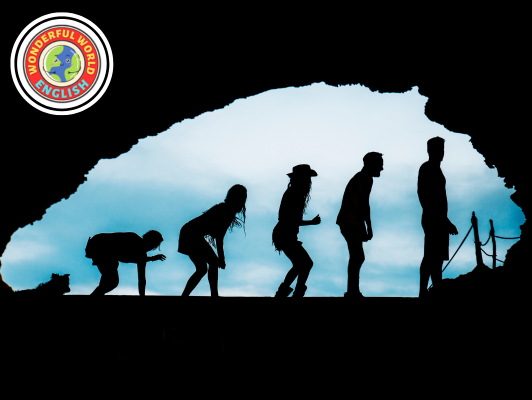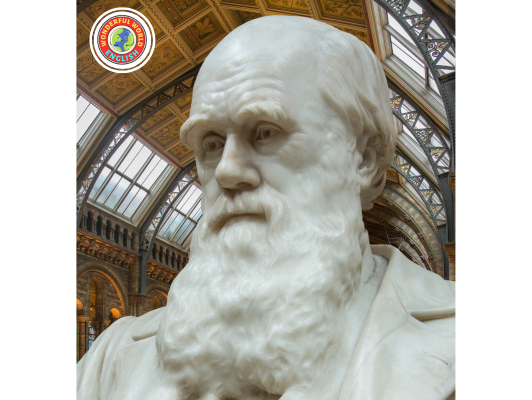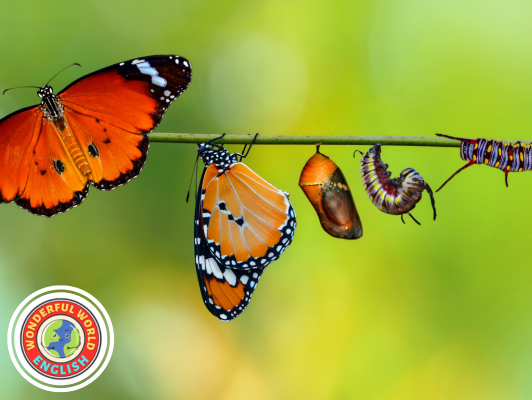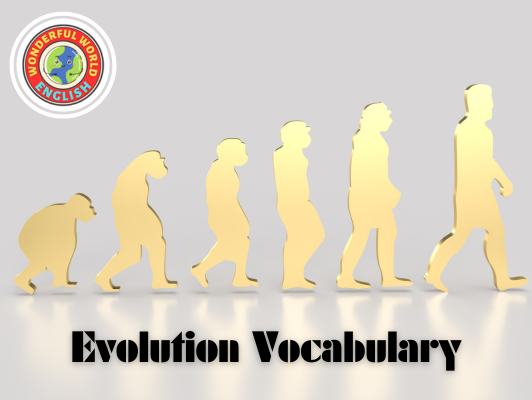Contents
Toggle
Meet David De’ Ath, founder, editor, and writer at Wonderful World English. With his extensive background as an English teacher, David provides valuable insights and practical tips on ESL for students and teachers alike.
Understanding evolution is essential to grasping how species change over time through the process of natural selection.
Evolution describes the gradual development of life on Earth, with each species adapting and transforming in response to environmental pressures.
Central to this concept is the role of natural selection, a mechanism first thoroughly expounded by Charles Darwin.
It operates on the principle that certain heritable traits confer a survival advantage, leading to an organism’s increased odds of reproducing and passing those beneficial traits onto the next generation.
The theory of evolution, supported by extensive scientific evidence, including fossil records and genetic data, provides a framework for biology, explaining the diversity of life and commonalities across species.
It posits that all living organisms share a common ancestor, diverging over time into the vast array of life forms observed today.
This process involves adaptation, where specific traits evolve to better suit an organism to its environment, contributing to the survival and success of that species.
The Basics of Evolution
Evolution is the process by which populations of organisms change over generations.
Genetic traits are inherited and can give rise to physical and behavioral changes that affect an organism’s ability to survive and reproduce.
Key Concepts and Definitions
Natural Selection: This is a central mechanism of evolutionary change first articulated by Charles Darwin. Organisms with traits that improve their chances of survival and reproduction are more likely to pass on their genes to the next generation.
- Genes: Units of heredity that carry the instructions an organism needs to develop, live, and reproduce.
- Trait: A characteristic of an organism that can be the result of genes and/or influenced by the environment.
- Population: A group of individuals of the same species that live in the same area and interbreed.
- Variation: Differences between individuals within a population, which may be due to genetic factors or environmental influences.
- Offspring: The progeny of an organism that have inherited traits from their parents.
The Historical Background of Evolutionary Theory
Charles Darwin is a pivotal figure in evolutionary theory. His observations led to the theory that natural selection drives the evolution of species. He noticed that offspring inherit traits from their parents and that there is variation within populations.
- Jean-Baptiste Lamarck: Another important scientist in the history of evolutionary theory. Lamarck’s theory of use and disuse suggested that organisms could pass on traits acquired during their lifetime to their offspring.
Fossil Record: Serves as historical evidence for evolution, showing a timeline of how organisms have changed over time. The fossil record supports the gradual changes in populations that lead to the diversity of life seen today.
| Term | Definition |
|---|---|
| Evolution | The process by which populations of organisms change over generations, with genetic traits influencing survival and reproduction. |
| Natural Selection | A mechanism of evolutionary change where organisms with traits that improve survival and reproduction chances are more likely to pass on their genes. |
| Genes | Units of heredity carrying instructions an organism needs to develop, live, and reproduce. |
| Trait | A characteristic of an organism, which can be influenced by genes and the environment. |
| Population | A group of individuals of the same species living in the same area and interbreeding. |
| Variation | Differences between individuals within a population due to genetic factors or environmental influences. |
| Offspring | The progeny of an organism, inheriting traits from their parents. |
| Genetic Drift | A random process that can cause gene frequencies to change over time, especially in small populations. |
| Gene Flow | The transfer of alleles between populations through migration, introducing new genetic variations. |
| Speciation | The process through which new biological species arise due to genetic isolation and other factors. |
| Macroevolution | Large-scale evolutionary changes that occur over long time periods, including the formation of new species and mass extinctions. |
| Fossil Record | The collection of fossils, which provides evidence of former life and the evolutionary history of life on Earth. |
| Comparative Anatomy | The study of similarities and differences in the structures of different organisms, indicating common ancestry. |
| Embryology | The branch of biology that studies the prenatal development of organisms, which can reveal evolutionary relationships. |
| Molecular Biology | The field of biology that studies the composition, structure, and interactions of cellular molecules like DNA and proteins. |
| Genetic Comparison | Analyzing the genetic material of different organisms to determine evolutionary relationships and time of divergence. |
Mechanisms of Evolutionary Change
The diversity of life on Earth is a result of different mechanisms of evolutionary change.
These mechanisms alter gene frequencies within populations over time, leading to adaptations and variations that can influence an organism’s ability to survive and reproduce.
Natural Selection and Adaptation
Natural selection is a pivotal mechanism in evolution, driving the process by which advantageous traits become more common in a population because they confer some benefit for survival and reproduction.
It acts directly on the phenotype, the observable characteristics of organisms.
If a particular phenotype provides a better adaptation to the environment, those individuals are more likely to survive and reproduce.
Over time, this can lead to an increase in the frequency of the associated allele in the gene pool, fueling microevolution and, on a much larger scale, macroevolution.
Genetic Drift and Gene Flow
Genetic drift is a random process that can cause gene frequencies to change over time, particularly in small populations.
It occurs independently of any advantages or disadvantages of a trait, leading to a change in genetic variation without direct selection.
Conversely, gene flow involves the transfer of alleles between populations through migration, which can introduce new genetic variations and alter allele frequencies within a population.
The combined effects of these mechanisms contribute to the overall pattern of evolution, shaping both the genotype and the phenotype of organisms across generations.

Speciation and Evolutionary Patterns
Speciation is the evolutionary process through which new biological species arise. Understanding this phenomenon is key to comprehending the vast diversity of life that populates Earth.
The study of evolutionary patterns provides insight into how species adapt and survive over time, often elucidated through phylogenetic analysis.
The Process of Speciation
Speciation occurs when populations of the same species become genetically isolated due to various barriers such as geographic separation or behavioral changes.
Over time, these populations experience descent with modification, leading to the accumulation of genetic differences.
If these differences become significant enough, they can prevent interbreeding, giving rise to distinct biological species.
This process can be witnessed in an evolutionary tree, which visually represents phylogeny and the historical relationships among species.
Patterns in Macroevolution
Macroevolution encompasses the broader scale evolutionary changes seen over long time periods.
It includes events like mass extinction, which drastically reduces species diversity, and subsequent phases like adaptive radiation, where a single species diversifies to fill various ecological niches.
Other patterns include punctuated equilibrium, a model suggesting that species experience little change for most of their history but then undergo rapid periods of speciation, and coevolution, the process by which two or more species reciprocally affect each other’s evolution.

Evidence for Evolution
Evolutionary biology provides a framework for understanding the changes in species over time through various strands of evidence.
These evidences draw from multiple scientific disciplines, which collectively reinforce our understanding of the theory of evolution.
Fossil Evidence and Paleontology
The study of fossils is a cornerstone in understanding evolution.
Paleontologists analyze the fossil record to trace the progression of life forms through different geological time periods.
Here, fossils provide a chronological account of species diversity and morphological changes, supporting the concept of descent with modification—a key principle of Darwinism.
Notable examples include the transition from aquatic to terrestrial vertebrates and the evolution of horses from small, multi-toed creatures to the large, single-toed animals we know today.
Comparative Anatomy and Embryology
Comparative anatomy reveals homologous structures in diverse organisms, indicating common ancestry.
For instance, the limb bones of humans, cats, whales, and bats are structurally similar despite serving different functions.
Furthermore, the comparison of embryonic development across species, known as embryology, illustrates how embryonic forms can show ancestral traits that may not be visible in adult organisms.
Such similarities in early development stages imply common genetic pathways and hint at shared evolutionary histories.
Molecular Biology and Genetics
At a molecular level, the study of DNA, genes, and mutations provides profound insight into evolutionary processes.
Genetic comparisons can determine relationships between species by analyzing similarities in DNA sequences. This is often referred to as the molecular clock, which estimates the time of divergence between species.
Insights from genetics not only confirm the patterns observed in fossil records and anatomy, but also reveal the mechanisms of evolution, such as natural selection and genetic drift, as underlying causes driving the variety of life we observe today.
Another important aspect of history is the American Civil War.
For a similar guide on its key vocabulary, check out the link below!
Related: Civil War Vocabulary: Key Terms Explained

Conclusion
Understanding evolution is pivotal for comprehending the intricacies of life’s development on Earth.
It encapsulates how species undergo transformations over generations through natural selection.
Evolutionary theory, underpinned by Charles Darwin’s seminal insights on natural selection, elucidates the dynamic processes through which organisms adapt to their environments, passing advantageous traits to their offspring.
This scientific framework, bolstered by a wealth of evidence from fossil records, genetics, and comparative biology, offers a comprehensive explanation for the biodiversity we witness today, illustrating a shared lineage among all living organisms.
By delving into the mechanisms of evolution, including genetic drift and gene flow, alongside the study of speciation and macroevolutionary patterns, we gain a profound understanding of the natural world, its past, present, and potential future, showcasing the unifying principles of biology that connect all forms of life.
We hope you find value in this information; you can contact us if you require any support.
Have a wonderful day!
Image Attribution: All images licensed via canva.com





